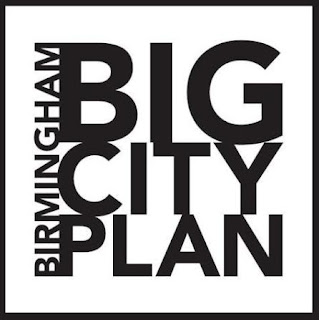Big City Plan consultation - a success?
 Despite the 'widespread', although I would argue not engaging, publicity as of the 24th March 2009 the Big City Plan had received 1905 comments from 283 contributors. Considering many of those commentators will be the active type of Birmingham citizen such as myself and other commentators such as Stef Lewandowski who have been following the Big City Plan, http://steflewandowski.com/, together with groups such as the Campaign for Better Transport and the Gooch Estate how many of these comments will have come from the ordinary citizen to whom the proposed ideas will have so much impact.
Despite the 'widespread', although I would argue not engaging, publicity as of the 24th March 2009 the Big City Plan had received 1905 comments from 283 contributors. Considering many of those commentators will be the active type of Birmingham citizen such as myself and other commentators such as Stef Lewandowski who have been following the Big City Plan, http://steflewandowski.com/, together with groups such as the Campaign for Better Transport and the Gooch Estate how many of these comments will have come from the ordinary citizen to whom the proposed ideas will have so much impact.The report notes that 2055 people/organisations were informed by letter. These people or organisations were sourced from the Council's consultation database and it would seem most of them did not comment or were unaware of the impact the plan would have on them. Of course if you didn't receive a letter you would have been made aware, by the various forms of publicity, of the website and the Big City Plan working draft in all it's beautiful bureaucratic language. The report notes that between 21st December 2008 to 24th March 2009 it was visited 13,408 times.
There were some community consultation events however, with one held on the 10th February at the Paragon Hotel for those with an interest in the Highgate, Digbeth, Eastside and Southside areas. This attracted 60 people. It's worth pondering how many more would have attended if the event was more focussed on translating the aims and ambitions of the plan to the average Brummie and taking their thoughts on the areas into ideas which will influence the development of planning documents and the 'core strategy'. With the areas this particular event focussed on experiencing upheaval 60 people attending is worryingly small. The gay village and issues of residential developments overshadowing the LGBT community, Digbeth and the continuing tussle between music venues and residents who want their 'peace and quiet' and Eastside's development of wasteland into a new eastern centre of the city centre surely merit the need to actively seek out more than 60 attendees views and much more than the 283 contributors who contributed comments to the consultation.
The council did run a 'Beyond the Midnight Bus' consultation covering morning, afternoon and early evening times over three days in Ladywood, Highgate and the City Centre which attracted 386 people but garnered only 88 responses at the time with 259 questionnaires taken away.
There was also a Mid-Term Conference held at the ICC attended by 281 people which provided the "opportunity for stakeholders and representatives from various organisations to discuss the Big City Plan".
So how do the comments that were received translate into the key themes and issues which will develop the next steps in the production of the Big City Plan. The following Wordle images, reproduced from Wordle and noted by Stef Lewandowski (Two Big City Plan Wordles), show the key words mentioned in the consultation document and the feedback received.
The original document, top 10,000 words, http://www.wordle.net/gallery/wrdl/495617/The_Birmingham_(UK)_Big_City_Plan

The comments on the Big City Talk website, (top 10,000 words), http://www.wordle.net/gallery/wrdl/495840/Big_City_Plan_comments

The wordle's illustrate the focus on the centre and reinforce my concerns that while Birmingham continues to regenerate it's city centre, which is nonetheless welcome, the suburbs and outlying areas are disadvantaged and do not share in the regeneration success seen by the developments such as the bullring and proposed metro extension. More of those thoughts to follow.
So what will happen with the comments received and the development of the Big City Plan. The report notes that the outcomes will be developed into the core strategy.
The next step for the Big City Plan has been primarily influenced following meetings withrepresentatives from Communities and Local Government and the Government Office for the West Midlands. It was identified that the most effective way forward, reflecting the strategic importance of the City Centre, is for a strategy for the City Centre to be included as a section in the Core Strategy and then site specific policy documents be produced to expand upon strategic policies and allocations.
The work to date on the Big City Plan along with the outcomes of the Work in progress consultation will be taken forward and developed in the Core Strategy. This element of the work will provide the strategic approach and policies for the City Centre. The timeline for this work will be linked with the Core Strategy and the timetable published in the Local Development Scheme.


Comments
Have you heard any updates on when the Core strategy document is going to be out?